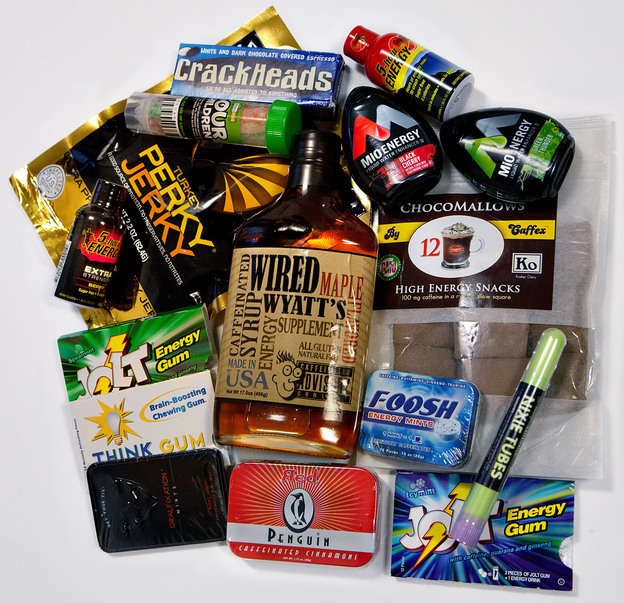Post by Allison Aubrey, The Salt at NPR
Listen to the story from NPR's All Things Considered (12/17/12):
Not Just For Coffee Anymore: The Rise Of Caffeinated Foods
Not Just For Coffee Anymore: The Rise Of Caffeinated Foods

That buzz from your morning cup of joe waning? How about a quick boost from caffeinated mints, gum, Perky Jerky or, from the makers of Cracker Jack, coffee-flavored Cracker Jack'd snacks?
It's not just coffee and tea and soda anymore. "There's a proliferation of foods; all kinds of things are now being caffeinated," says Michael Jacobson of the Center for Science in the Public Interest.
In many cases, manufacturers are promoting their foods as pick-me-ups, but they're not labeling how much caffeine is included in the products. Currently, the Food and Drug Administration does not require it. And that's raising some questions about how much caffeine we're getting these days.
"I think at a minimum the FDA should require the amount of caffeine to be disclosed on product labels," says Jacobson. And some caffeine researchers seem to agree.
"Caffeine is a drug," explains Abraham Palmer of the University of Chicago. And partly because of genetic differences, "there's a lot of variation in the way people experience the effects of caffeine."
Palmer says he loved caffeine from the day he had his first cup of coffee at age 14. It gives him a lift and makes him feel more alert. But "there are others, such as my wife, who really hate caffeine, because it makes them feel jittery and anxious."
Given that some people are sensitive to even small shifts in caffeine consumption, Palmer says is would be helpful to consumers if manufacturers had to label amounts. "It's hard for me to see what the downside would be," says Palmer.
And Jennifer Temple of the University of Buffalo, who studies how adolescents respond to caffeine, says: "The more information you can give consumers and parents about the caffeine content in beverages and foods, the better. It allows them to make more informed decisions."
If you listen to my story, you'll hear about one of Temple's research studies that suggest teenage boys seem to be motivated to seek out caffeine after they're exposed to it for a short period. And other studies have shown that caffeine has a reinforcing effect on consumption. Meaning if someone drinks coffee and experiences a pleasant buzz, it reinforces a coffee habit.
This doesn't make caffeine dangerous, but it raises questions about how it's regulated.
"I think it's a real concern to add a mildly addictive stimulant drug to all kinds of things. And it's a special risk to kids," says Jacobson.
Jacobson raised a stink when Frito-Lay, maker of the iconic molasses-coated peanut and popcorn Cracker Jack candy with the prize inside, announced plans for its new line of snacks called Cracker Jack'd, some of which will contain coffee.
But Frito-Lay says it is not marketing these products to children. "All marketing for the products will be exclusively aimed at adult consumers," Alexia Allina of Frito-Lay told us in an email. "And the presence of coffee and the caffeine that comes with it is clearly called out on both the front and back of the package."
Owing to the varying caffeine content of coffee, Frito-Lay says the caffeine content in its snack may vary, too. But in general, it expects the snack to contain approximately 70 mg (equivalent to about two-thirds of a cup of coffee) of caffeine in each 2-ounce package.
Copyright 2012 National Public Radio.
